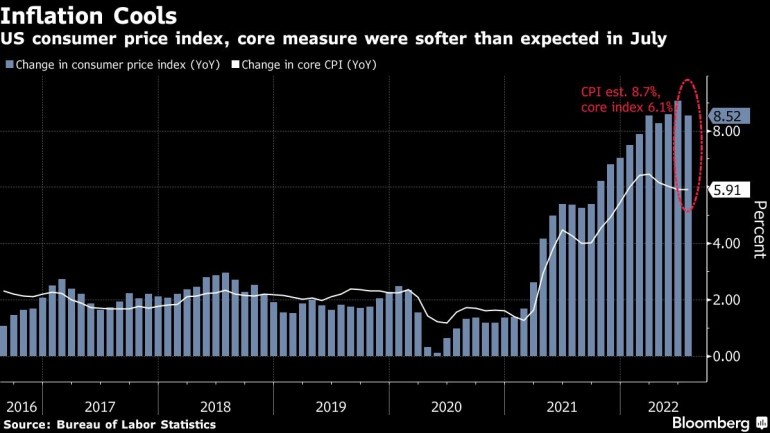US July inflation falls more than forecast on lower petrol prices
Core CPI, which excludes volatile components like food and fuel, climbed 5.9 percent compared with a year ago.

US inflation decelerated in July by more than expected, reflecting lower energy prices, which may take some pressure off the Federal Reserve to continue aggressively hiking interest rates.
The consumer price index increased 8.5% from a year earlier, cooling from the 9.1% June advance that was the largest in four decades, Labor Department data showed Wednesday. Prices were unchanged from the prior month. A decline in gasoline offset increases in food and shelter costs.
Keep reading
list of 4 itemsWhat the blowout US jobs numbers actually mean
US jobless claims climb again, near highest since November
‘Uncharted territory’: Five key takeaways on US inflation
So-called core CPI, which strips out the more volatile food and energy components, rose 0.3% from June and 5.9% from a year ago. The core and overall measures came in below forecast.

The data may give the Fed some breathing room, and the cooling in gas prices, as well as used cars, offers respite to consumers. But annual inflation remains high at more than 8% and food costs continue to rise, providing little relief for President Joe Biden and the Democrats ahead of midterm elections.
Cost of Living
While a drop in gasoline prices is good news for Americans, their cost of living is still painfully high, forcing many to load up on credit cards and drain savings. After data last week showed still-robust labor demand and firmer wage growth, a further deceleration in inflation could take some of the urgency off the Fed to extend outsize interest-rate hikes.
Treasury yields slid across the curve while S&P 500 futures extended gains and the dollar plunged. Traders reduced the odds of the US central bank boosting rates by three-quarter percentage point next month.
Gasoline prices fell 7.7% in July, the most since April 2020, after rising 11.2% a month earlier. Utility prices fell 3.6% from June, the most since May 2009.
Food costs, however, climbed 10.9% from a year ago, the most since 1979. Used car prices decreased.
Even though inflation decelerated, Fed officials have said they want to see months of evidence that prices are cooling, especially in the core gauge. They’ll have another round of monthly CPI and jobs reports before their next policy meeting on Sept. 20-21.
Housing Costs
Shelter costs — which are the biggest services’ component and make up about a third of the overall CPI index — rose 0.5% from June and 5.7% from last year, the most since 1991. That reflected a 0.7% jump in rent of primary of residence. Hotels, meanwhile, fell 3.2%.
Elsewhere in leisure, airfares dropped 7.8% from the prior month, the most in nearly a year.
While prices are showing signs of moderating, there are several factors that risk keeping inflation high. Housing costs are a big one, as well as unexpected supply shocks. And wages are still climbing at a historically fast pace, concerning some economists of a so-called wage-price spiral.
However, those gains aren’t keeping up with inflation. A separate report showed real average hourly earnings fell 3% in July from a year earlier, dropping every month since April 2021. The impact of inflation on wages has started to dent spending, with the pace of personal consumption growth decelerating between the first and second quarters.
That said, consumer expectations for US inflation declined sharply in the latest survey by the New York Fed, suggesting Americans have some confidence that prices will come off the boil in the next one to five years.
(Adds graphic)
–With assistance from Kristy Scheuble, Reade Pickert and Liz Capo McCormick.